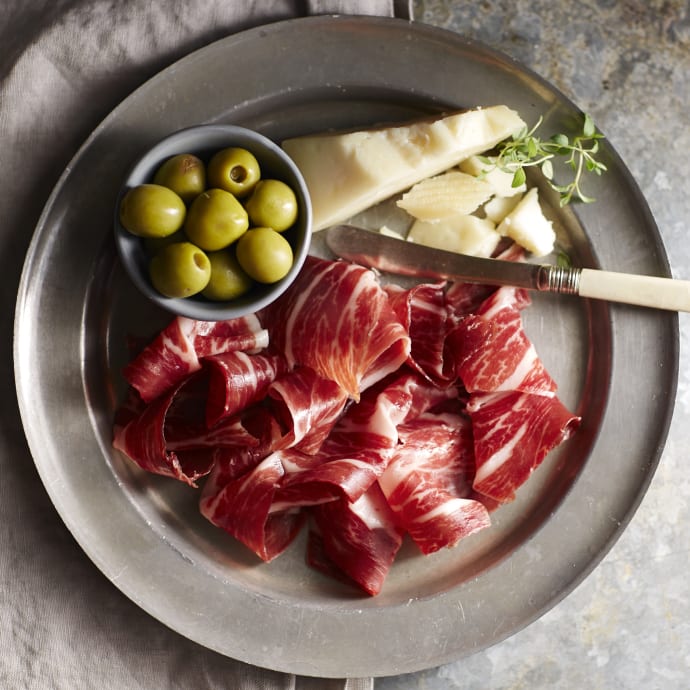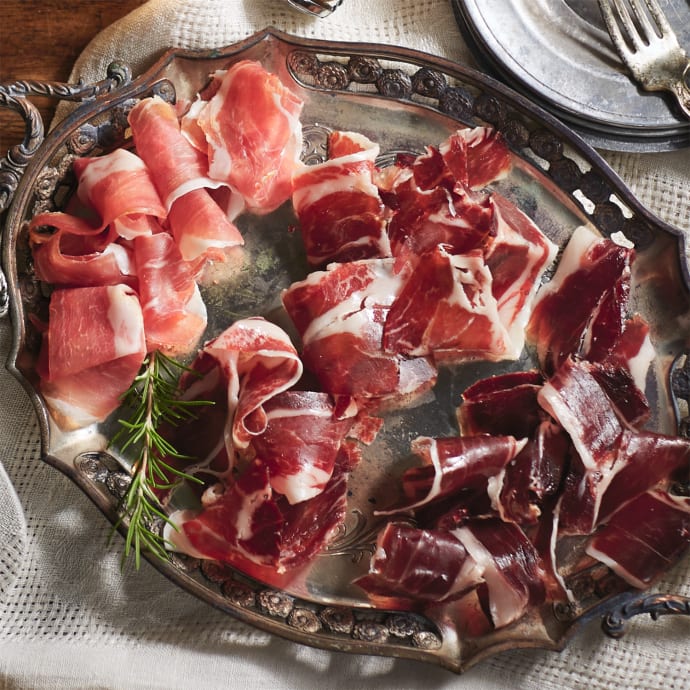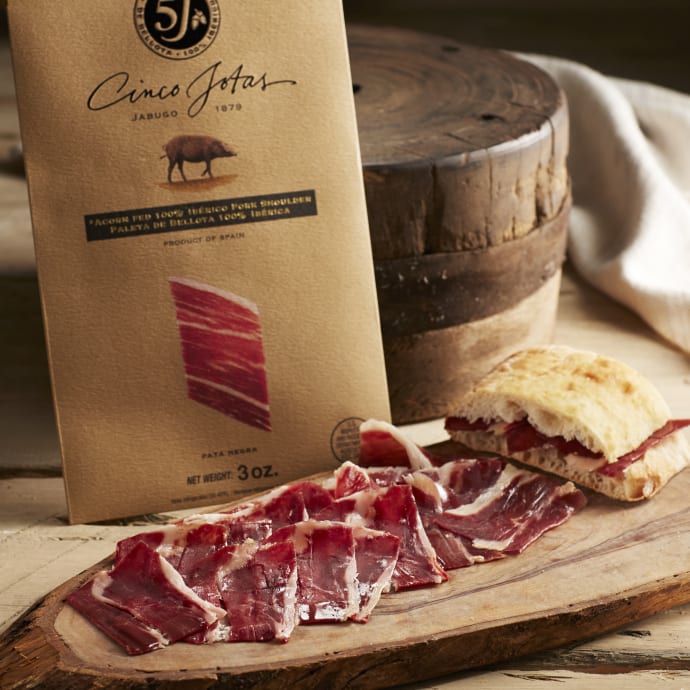Three Kings Sale - Up to 40% Off! Shop Sale

Jamon Iberico de Bellota tastes like every penny
Fort Worth Star Telegram
-
September 3, 2008
Amy Culbertson
Fort Worth Central Market just received its first-ever shipment of the pricey jamon iberico de bellota, from Spain.
Star-Telegram/Paul Moseley
Jamon iberico de bellota is best eaten alone and not recommended for cooking, especially with its $179.99-a-pound price tag. S-T/Paul Moseley
It’s the holy grail of hamdom, pig made transcendent by a life of feasting on acorns in oak meadows, transformed by salt and mountain air and time.
It’s also the most expensive ham you’ll ever meet. It’s Spain’s fabled jamon iberico de bellota, and until this summer, you couldn’t get it in the United States. Now you can buy it at area Central Markets — but bring your credit card: It sells for $179.99 a pound.
What could make a piece of pig so expensive?
It starts with the breed. Most Spanish hams, called serranos, are made from regular pink or white pigs (often raised in northern Europe).
The noble piggies that produce the iberico ham, though, are native to southwestern Spain and Portugal; Columbus, we’re told, had some on board for his New World voyage. This cerdo iberico breed is also known as pata negra, or black-hoofed; the hams are often sold with hoof attached.
These hogs are hard to produce and expensive to raise, explains Spanish-food importer Don Harris of Virginia-based La Tienda. "The sows don’t have many babies."
But they have a unique ability to store fat, which is marbled throughout the meat, and the luckiest of them roam free in southern Spain’s oak meadows, fattening on acorns — bellotas — which give the fat a high level of healthy monounsaturated oleic acid.
The acorns give the bellota ham its distinctive flavor, as well, and "because he’s run around rather than sitting in a pen, the fat is distributed through the muscles," Harris says. (There are lower grades of iberico ham, still prized but less expensive, from iberico pigs that have been fed on acorns for a shorter time or raised entirely on grain.)
The more time it takes to produce something, the more it’s going to cost, and the bellota pigs live longer than their more plebeian brethren before they’re slaughtered — or, as they say in Spain, "sacrificed" — gently, with carbon dioxide, so as not to raise their stress level and release adrenaline, which would affect the meat. They’re even serenaded with Mozart the night before to keep them mellow, Harris tells The Boston Globe. They’re cured longer, too — up to four years; the aging confers additional depth and complexity of flavor.
Then there’s the fact that the hams are hard to get. Folks who’d tasted iberico ham on trips to Spain pined wistfully for it on their return. Until the Fermin company built a special slaughterhouse in Spain to meet U.S. Agriculture Department standards, iberico couldn’t be imported.
From the new Fermin plant, as their curing periods ended, the lesser grades of iberico arrived over the past couple of years. Meanwhile, foodies and porkophiles waited as the bellota hams cured. Online importer La Tienda had a waiting list of hundreds. Finally, this summer, the bellota hams were shipped. Central Market says it’s the only retailer selling them in the Southwest.
But how does it taste?
That is why I show up at the Fort Worth Central Market on a recent morning, excited to get my first taste. Deli and cheese manager Brandon Campbell and sous-chef Andrew Dilda are laying out petal-thin slices of prosciutto di Parma and San Daniele Secola 20-month prosciutto; Spanish jamon serrano; and three types of iberico — regular jamon iberico; shoulder (paleta) of iberico de bellota; and the crown jewel, the just-arrived jamon iberico de bellota.
I taste my way up the scale. The prosciuttos are delicious, but the darker serrano is gamier, more complex. The iberico cuts, though, with their deep, rich, nutty, aromatic flavor that resonates in the mouth, make me forget the hams that came before. The glistening wine-red bellota slices are edged with fat the color of old ivory; the fat — more prominent in the paleta — seems to melt on the tongue. After I swallow, the flavor hums in my mouth for minutes.
So, is this ham that much better than other hams? Yes. Even the less expensive regular iberico, at $99.99 a pound, is light-years above its Spanish and Italian cousins. Indeed, the much-anticipated arrival of the bellota iberico has one happy side effect for me: It makes me feel less guilty about splurging on the regular iberico — after all, it’s almost a bargain, right?
Is it worth paying $25 for 10 or 12 paper-thin slices of bellota ham? That depends on you. The Central Market deli folks will allow you a small sample to try. But I warn you: The stuff is addictive; it tends to ruin you for lesser hams. And it will put you on the horns of a dilemma: Foodstuffs this dear are usually reserved for special occasions, but you will be tempted to keep it not only from your guests but also from your loved ones, to savor every rich shard and morsel by yourself.
About iberico
What it is All iberico cured meats are made from the cerdo iberico, or pata negra, breed of pig. The difference in grades lies in how they were raised.
Iberico de bellota comes from pigs that range free on the dehesa, or oak meadows, grazing on acorns. Central Markets sell bellota jamon (ham) for $179.99 a pound and paleta (shoulder) for $119.99. At www.latienda.com, the sliced paleta is $34.50 for 4 ounces ($138 a pound), and a whole bone-in iberico de bellota ham is $96 a pound, or about $1,400.
Iberico ham comes from pigs raised on farms and fed on grain. Central Market sells it for $99.99 a pound; www.latienda.com for $24.50 for a 4-ounce package of slices ($98 a pound).
How to say it Jamon iberico de bellota is pronounced "hah-MOAN Ee-BARE-ee-ko day bay-YO-tuh."
How to use it Iberico is best eaten the same day it is cut, but it can be stored for a week; keep it in the refrigerator’s vegetable drawer in the zip-lock bag from the store.
Ham of this quality should be sliced very thinly and savored as an appetizer or snack. Iberico is not ham you cook with — "that would be like deep-frying with truffle oil," Fort Worth Central Market sous-chef Andrew Dilda says wryly. If you want to serve it as part of an appetizer spread, Central Market bakery, deli and cheese business development manager Edouard Damez suggests ripe figs and aged Spanish cheeses such as an artisanal Manchego, raw-milk Ibores or Ossau-Iraty. But, he notes, it "should really be enjoyed by itself."
To drink, Fort Worth Central Market wine and beer manager J.R. Clark suggests Spanish wines: For whites, a light, crisp Albarino from Rias Baixas; or the sparkling Gramona Gran Reserva Cava ($14.99); or the bright Oreka Txakoli from the Basque region ($19.95). For reds, he suggests a tempranillo such as the $14.99 Mibal Tinto, or, should you wish to splurge on the wine as well as the ham, the massive Vizcarra Celia or Vizcarra Inés, from the Ribera del Duero, at $129.99. Sherry is always appropriate, too.
To learn more Taste the jamon iberico de bellota at a "Taste of Spain" class at the Fort Worth Central Market at 6:30 p.m. Oct. 24 ($60). Clark and deli and cheese manager Brandon Campbell will lead a class on Spanish cured meats, wines and cheeses; 817-377-9005.
La Tienda has information about Spanish hams on a special Web site, www.jamon.com, as well as at www.latienda.com.
Amy Culbertson is the Star-Telegram food editor, 817-390-7421
Fort Worth Central Market just received its first-ever shipment of the pricey jamon iberico de bellota, from Spain.
Star-Telegram/Paul Moseley
Jamon iberico de bellota is best eaten alone and not recommended for cooking, especially with its $179.99-a-pound price tag. S-T/Paul Moseley
It’s the holy grail of hamdom, pig made transcendent by a life of feasting on acorns in oak meadows, transformed by salt and mountain air and time.
It’s also the most expensive ham you’ll ever meet. It’s Spain’s fabled jamon iberico de bellota, and until this summer, you couldn’t get it in the United States. Now you can buy it at area Central Markets — but bring your credit card: It sells for $179.99 a pound.
What could make a piece of pig so expensive?
It starts with the breed. Most Spanish hams, called serranos, are made from regular pink or white pigs (often raised in northern Europe).
The noble piggies that produce the iberico ham, though, are native to southwestern Spain and Portugal; Columbus, we’re told, had some on board for his New World voyage. This cerdo iberico breed is also known as pata negra, or black-hoofed; the hams are often sold with hoof attached.
These hogs are hard to produce and expensive to raise, explains Spanish-food importer Don Harris of Virginia-based La Tienda. "The sows don’t have many babies."
But they have a unique ability to store fat, which is marbled throughout the meat, and the luckiest of them roam free in southern Spain’s oak meadows, fattening on acorns — bellotas — which give the fat a high level of healthy monounsaturated oleic acid.
The acorns give the bellota ham its distinctive flavor, as well, and "because he’s run around rather than sitting in a pen, the fat is distributed through the muscles," Harris says. (There are lower grades of iberico ham, still prized but less expensive, from iberico pigs that have been fed on acorns for a shorter time or raised entirely on grain.)
The more time it takes to produce something, the more it’s going to cost, and the bellota pigs live longer than their more plebeian brethren before they’re slaughtered — or, as they say in Spain, "sacrificed" — gently, with carbon dioxide, so as not to raise their stress level and release adrenaline, which would affect the meat. They’re even serenaded with Mozart the night before to keep them mellow, Harris tells The Boston Globe. They’re cured longer, too — up to four years; the aging confers additional depth and complexity of flavor.
Then there’s the fact that the hams are hard to get. Folks who’d tasted iberico ham on trips to Spain pined wistfully for it on their return. Until the Fermin company built a special slaughterhouse in Spain to meet U.S. Agriculture Department standards, iberico couldn’t be imported.
From the new Fermin plant, as their curing periods ended, the lesser grades of iberico arrived over the past couple of years. Meanwhile, foodies and porkophiles waited as the bellota hams cured. Online importer La Tienda had a waiting list of hundreds. Finally, this summer, the bellota hams were shipped. Central Market says it’s the only retailer selling them in the Southwest.
But how does it taste?
That is why I show up at the Fort Worth Central Market on a recent morning, excited to get my first taste. Deli and cheese manager Brandon Campbell and sous-chef Andrew Dilda are laying out petal-thin slices of prosciutto di Parma and San Daniele Secola 20-month prosciutto; Spanish jamon serrano; and three types of iberico — regular jamon iberico; shoulder (paleta) of iberico de bellota; and the crown jewel, the just-arrived jamon iberico de bellota.
I taste my way up the scale. The prosciuttos are delicious, but the darker serrano is gamier, more complex. The iberico cuts, though, with their deep, rich, nutty, aromatic flavor that resonates in the mouth, make me forget the hams that came before. The glistening wine-red bellota slices are edged with fat the color of old ivory; the fat — more prominent in the paleta — seems to melt on the tongue. After I swallow, the flavor hums in my mouth for minutes.
So, is this ham that much better than other hams? Yes. Even the less expensive regular iberico, at $99.99 a pound, is light-years above its Spanish and Italian cousins. Indeed, the much-anticipated arrival of the bellota iberico has one happy side effect for me: It makes me feel less guilty about splurging on the regular iberico — after all, it’s almost a bargain, right?
Is it worth paying $25 for 10 or 12 paper-thin slices of bellota ham? That depends on you. The Central Market deli folks will allow you a small sample to try. But I warn you: The stuff is addictive; it tends to ruin you for lesser hams. And it will put you on the horns of a dilemma: Foodstuffs this dear are usually reserved for special occasions, but you will be tempted to keep it not only from your guests but also from your loved ones, to savor every rich shard and morsel by yourself.
About iberico
What it is All iberico cured meats are made from the cerdo iberico, or pata negra, breed of pig. The difference in grades lies in how they were raised.
Iberico de bellota comes from pigs that range free on the dehesa, or oak meadows, grazing on acorns. Central Markets sell bellota jamon (ham) for $179.99 a pound and paleta (shoulder) for $119.99. At www.latienda.com, the sliced paleta is $34.50 for 4 ounces ($138 a pound), and a whole bone-in iberico de bellota ham is $96 a pound, or about $1,400.
Iberico ham comes from pigs raised on farms and fed on grain. Central Market sells it for $99.99 a pound; www.latienda.com for $24.50 for a 4-ounce package of slices ($98 a pound).
How to say it Jamon iberico de bellota is pronounced "hah-MOAN Ee-BARE-ee-ko day bay-YO-tuh."
How to use it Iberico is best eaten the same day it is cut, but it can be stored for a week; keep it in the refrigerator’s vegetable drawer in the zip-lock bag from the store.
Ham of this quality should be sliced very thinly and savored as an appetizer or snack. Iberico is not ham you cook with — "that would be like deep-frying with truffle oil," Fort Worth Central Market sous-chef Andrew Dilda says wryly. If you want to serve it as part of an appetizer spread, Central Market bakery, deli and cheese business development manager Edouard Damez suggests ripe figs and aged Spanish cheeses such as an artisanal Manchego, raw-milk Ibores or Ossau-Iraty. But, he notes, it "should really be enjoyed by itself."
To drink, Fort Worth Central Market wine and beer manager J.R. Clark suggests Spanish wines: For whites, a light, crisp Albarino from Rias Baixas; or the sparkling Gramona Gran Reserva Cava ($14.99); or the bright Oreka Txakoli from the Basque region ($19.95). For reds, he suggests a tempranillo such as the $14.99 Mibal Tinto, or, should you wish to splurge on the wine as well as the ham, the massive Vizcarra Celia or Vizcarra Inés, from the Ribera del Duero, at $129.99. Sherry is always appropriate, too.
To learn more Taste the jamon iberico de bellota at a "Taste of Spain" class at the Fort Worth Central Market at 6:30 p.m. Oct. 24 ($60). Clark and deli and cheese manager Brandon Campbell will lead a class on Spanish cured meats, wines and cheeses; 817-377-9005.
La Tienda has information about Spanish hams on a special Web site, www.jamon.com, as well as at www.latienda.com.
Amy Culbertson is the Star-Telegram food editor, 817-390-7421
Other Press
The Winter Travel Shortlist: Problem-Solving Essentials I’m Packing This Season
Forbes
-
November 20, 2025
54 Gifts for People Who Have Everything
Wirecutter
-
November 6, 2025
What Andrew Zimmern Can’t Live Without
The Strategist
-
June 30, 2025
8 Tasty Ways To Travel The World With Food
Forbes
-
June 17, 2025
Featured Products
 SHIPS FREE
SHIPS FREECinco Jotas Boneless 100% Ibérico de Bellota Jamón - FREE SHIPPING!
JM-107
(2)
$1,599.00$1,599.00
 SHIPS FREE
SHIPS FREECinco Jotas Bone-In 100% Ibérico de Bellota Jamón - FREE SHIPPING!
JM-106
(4)
$1,599.00$1,599.00
 BEST SELLER
BEST SELLERSliced Ibérico Ham by Peregrino, Nitrate Free - 2 oz
JM-23
(38)
$28.00$28.00
 BEST SELLER
BEST SELLERSliced Ibérico de Bellota Ham by Peregrino, Nitrate Free - 2 oz
JM-52
(47)
$42.00$42.00
 BEST SELLER
BEST SELLERJamón Tasting Trio of Sliced Ham
JM-25
(38)
$85.00$85.00
 BEST SELLER
BEST SELLERCured Meats of Spain Sampler
JM-45
(39)
$109.00$109.00
 BEST SELLER
BEST SELLERCinco Jotas Sliced 100% Ibérico de Bellota Shoulder - 3 oz
JM-111
(22)
$55.00$55.00







